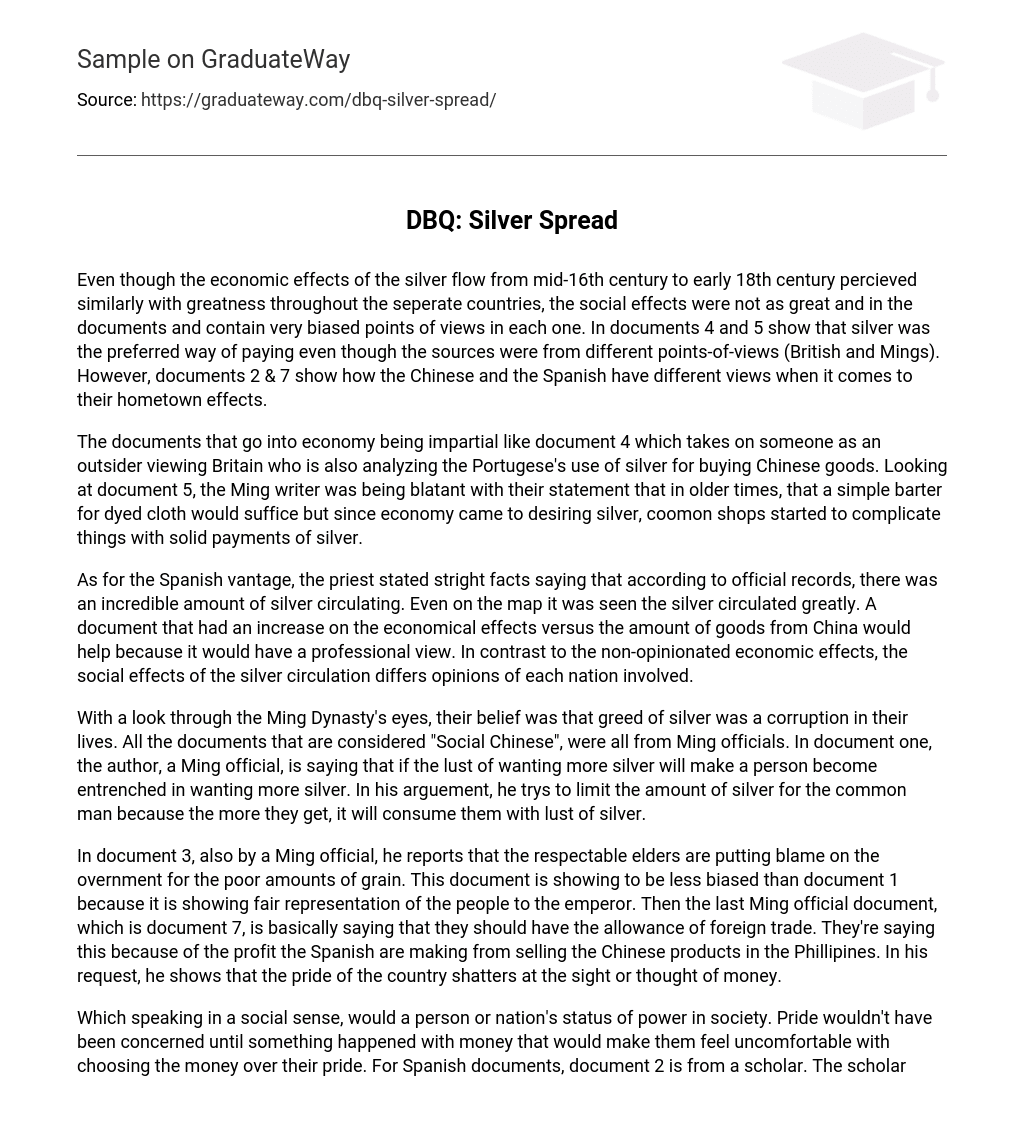Even though the economic effects of the silver flow from mid-16th century to early 18th century percieved similarly with greatness throughout the seperate countries, the social effects were not as great and in the documents and contain very biased points of views in each one. In documents 4 and 5 show that silver was the preferred way of paying even though the sources were from different points-of-views (British and Mings). However, documents 2 & 7 show how the Chinese and the Spanish have different views when it comes to their hometown effects.
The documents that go into economy being impartial like document 4 which takes on someone as an outsider viewing Britain who is also analyzing the Portugese’s use of silver for buying Chinese goods. Looking at document 5, the Ming writer was being blatant with their statement that in older times, that a simple barter for dyed cloth would suffice but since economy came to desiring silver, coomon shops started to complicate things with solid payments of silver.
As for the Spanish vantage, the priest stated stright facts saying that according to official records, there was an incredible amount of silver circulating. Even on the map it was seen the silver circulated greatly. A document that had an increase on the economical effects versus the amount of goods from China would help because it would have a professional view. In contrast to the non-opinionated economic effects, the social effects of the silver circulation differs opinions of each nation involved.
With a look through the Ming Dynasty’s eyes, their belief was that greed of silver was a corruption in their lives. All the documents that are considered “Social Chinese”, were all from Ming officials. In document one, the author, a Ming official, is saying that if the lust of wanting more silver will make a person become entrenched in wanting more silver. In his arguement, he trys to limit the amount of silver for the common man because the more they get, it will consume them with lust of silver.
In document 3, also by a Ming official, he reports that the respectable elders are putting blame on the overnment for the poor amounts of grain. This document is showing to be less biased than document 1 because it is showing fair representation of the people to the emperor. Then the last Ming official document, which is document 7, is basically saying that they should have the allowance of foreign trade. They’re saying this because of the profit the Spanish are making from selling the Chinese products in the Phillipines. In his request, he shows that the pride of the country shatters at the sight or thought of money.
Which speaking in a social sense, would a person or nation’s status of power in society. Pride wouldn’t have been concerned until something happened with money that would make them feel uncomfortable with choosing the money over their pride. For Spanish documents, document 2 is from a scholar. The scholar makes complaints about the way the government is using their spendings. What he is saying is that with how the government is spending far too much of their silver for Asian-goods. They spent so much of their own silver, that it began to ruin Spain.
Finally, document 8 comes from an English scholar. Figuratively, he’s riding in the same boat as the Spaniard. Just as the Spaniard ideas were saying, the English scholar is also saying that Europe is becoming far too enticed with Asian goods. His specific argument is that they’re just giving away money basically, for petty materials that won’t have alot of use in the long run for them. He also says that the government’s putting in indulgence pointlessly because it will never be returned to Europe, which will cause Europe to fall into peril.
A document that could be added that would help with the social area of the silver flow would probably be a diary kept by an American traveler. He/she would be able to give an accurate analysis of the social effects of the silver flow since, as an outsider, he/she would be impartail to the situation. Upon the documents given, the economic effects were very similar with the countries that were involved, where in the social sense; the viewpoints are varied depending on nationality and postition of the source who wrote the document. (Such as someone high as a Chinese official)





